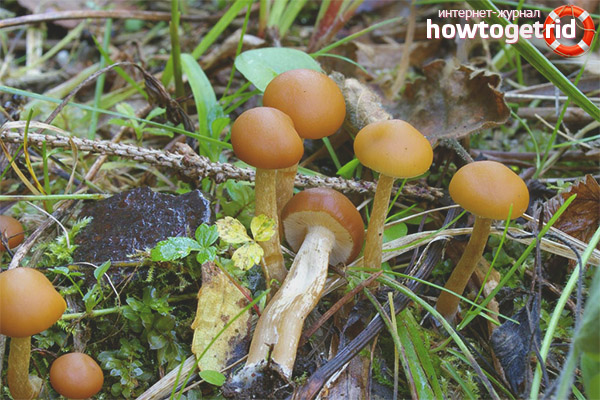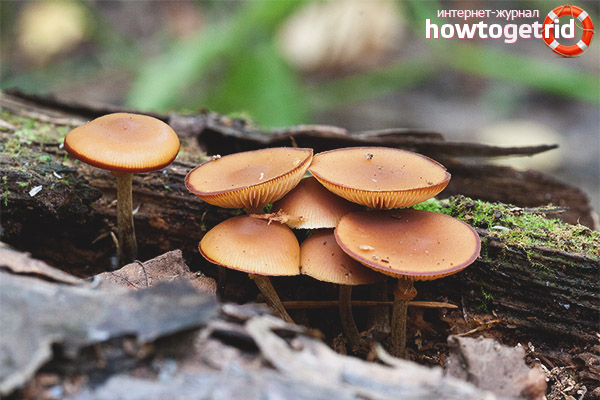The content of the article
The main danger posed by the poisonous mushroom galerine bordered in that it is very similar to the summer mushroom favorite by mushroom pickers. Poisoning with this fungus in some cases leads to death.
Description and distribution of the fungus
Galerina marginata is included in the stropharia family of agaricomycetes. Since the danger of this fungus is beyond doubt, it is important to know its distinguishing features:
- The hat is brown in color, can also have a yellowish tint, reaches 4 cm in size, smooth, slightly shiny. At the beginning of its growth, it is convex, may have the shape of a bell, bent inward at the edges. As it develops, the hat straightens to a flat state, its edges become translucent with parallel grooves visible on them.
- It has narrow, closely spaced plates. At first they are light in color, and when maturing, the spores change to brown with a rusty tint. When they appear, young mushrooms are equipped with a film on the bottom of the hat, which then breaks and hangs like a ring on a leg.
- Bordered galleria spores are painted in a pronounced rusty color.
- The foot is thickened at the base, reaches a maximum length of 5 cm and a thickness of half a centimeter. It is painted brown with a yellow ring at the top, which subsequently disappears. Above the ring, the leg is covered with a coating of mealy structure, and below - its color is closer to the color of the hat. Inside it is hollow.
- The pulp has a persistent powdery aroma. By coloring, it is more yellow in the cap of the mushroom and more brown in its leg.
Galerine bordered quite widespread. It can be seen in the forests of Asia, Europe, North America and Australia. In Russia, gallery is found in the European part, including in the Crimea and the Caucasus, as well as in the Far East, the Urals and southern Siberia. The fungus prefers dead coniferous tree trunks, even if they lie shallow in the ground. It can also live in mosses or on tree roots protruding from the soil. The fruiting bodies of the galley bordered appear in August and occur until October.
Difference of a galley bordered from a summer open-air
In order not to confuse this poisonous mushroom with the usual summer open-air mushroom, with which they are very similar, it is necessary to understand their differences. And the galerine-bordered and edible mushroom have a similar shape, color and size, have a ring on the leg and mature in about one time. Not a very pleasant moment is that galeries can sprout individually among a group of honey mushrooms, so you can accidentally cut off poisonous mushrooms along with edible mushrooms. In such a situation, there will not be severe poisoning from one thing. In addition, both mushrooms prefer stumps and fallen trees.
But there are still visible differences between them:
- Galerina is smaller in size, and in small mushrooms the hat tucks around the edges.
- Fringed galerine is found mainly in coniferous forests, and summer honey agaric grows in deciduous or mixed.
- In the gallery, the lower leg in terms of structure is fibers and is covered with white plaque in the form of spots, while in the open leg the leg is covered with scales.
- If you smell the flesh of a gallery, you can smell the floury smell, while honey agaric has a fresh smell of wood.
- Galerias are not connected by legs at their base, and this is often the case with honey mushrooms.
Experienced mushroom pickers on these grounds will be able to distinguish a dangerous mushroom from an edible one. However, in order not to risk life and health, it is necessary to adhere to the following recommendations:
- Collect summer mushrooms in deciduous forests and do not go after him in conifers.
- Take only young mushrooms, because in adulthood, their differences are almost imperceptible.
Signs of poisoning and first aid
The venom of a galerine bordered is amatoxin. It is very similar to the poisonous substance contained in a pale toadstool. The poison acts on the liver, destroying it, but the danger is that this does not happen right away. From the moment of poisoning to the stage of its acute manifestation, 10-14 hours pass. After acute poisoning, a period of improvement in health is observed for 3 days, and then the person's condition deteriorates sharply. If timely medical assistance is not provided, then a fatal outcome is possible.
When ingested amatoxin, the following manifestations occur:
- incessant vomiting;
- diarrhea;
- frequent urination
- cramps
- decreasing body temperature.
If such signs occur, then you must immediately call an ambulance. While the team is traveling, it is necessary to provide the first aid to the victim: gastric lavage; ensuring peace; warming the limbs, for example, using heating pads; warm drinking in large quantities, with a pronounced weakness, it is permissible to give tightly brewed tea. If a person is in the hands of qualified medical workers within one day after the poisoning, then the probability of a favorable outcome is very high.
Other types of gallery
In addition to the gallery bordered, there is a danger of stumbling upon its closest relatives - the sphagnum gallery and the moss gallery.
Sphagnum galerine is also an inedible fungus. Her hat in diameter does not exceed 3.5 cm. In shape, it can vary from cone to convex. On the surface, the hat is both smooth and with fibers. It absorbs water well. The mushroom is painted in brown with a yellowish tint. The leg is very thin, up to 0.4 cm in diameter and has a large length - up to 12 cm, hollow inside. These mushrooms are found from June to September. Their favorite places are moist lowlands and swamps, where they grow in large families.
Moss galerin is a mushroom containing dangerous poison. The hat is very small, no more than one and a half centimeters in diameter. As it grows, its shape changes from a cone to a hemisphere, and in the end it becomes convex. It swells, absorbing moisture from the environment. It has a light brown color, but may also be yellow with a honey tint. The leg is thin - 0.2 cm and not very high - reaches 4 cm in length. Young mushrooms have a ring on the stem, but in adulthood it disappears. Fruiting begins in August and continues until September. Prefers to grow in moss and old dead wood. It is not often found alone, it likes to grow in small groups.
To protect yourself in the forest when collecting mushrooms, you need to know exactly the differences between edible and poisonous specimens. If in doubt, it is better not to take such mushrooms.
Video: Galerina edged (Galerina marginata)












Submit